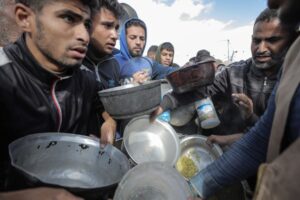Targeted aid killings: How Israel starved a population and sowed chaos in northern Gaza

Displaced Palestinians rush to get a warm meal distributed by charity organizations amid the worsening humanitarian crisis and starvation due to Israeli embargo, Deir al-Balah, Gaza, 26 November 2024
Riley Sparks, Hajar Harb, Omar Nabil Abdel Hamid and Eric Reidy report in Mondoweiss on 3 December 2024:
Earlier this year, as northern Gaza hurtled towards famine under Israeli bombardment and siege, UN agencies undertook an emergency effort to try to deliver food aid safely to hundreds of thousands of people on the brink of starvation.
To secure deliveries, the agencies – including the World Food Programme (WFP) and the UN’s aid coordination body, OCHA – turned to the local Palestinian community, which formed emergency committees composed of members of prominent families and tribes, and other volunteers.
For a few days in mid-March, the system worked. UN convoys brought significant amounts of food aid into parts of northern Gaza that had been cut off since near the start of the war, without the looting or Israeli attacks and interference that had been impeding humanitarian relief efforts for months.
But then – less than 48 hours after the first successful delivery – an Israeli airstrike on 18 March hit a warehouse used to store aid for the initiative, killing two people working there. Over the next two weeks, in what appears to be a series of targeted strikes on individuals and key distribution points, the Israeli military went on to kill more than 100 Palestinians – those involved in the effort and, in many cases, family members and civilians who just happened to be nearby.
These repeated attacks forced the committees to back out, effectively crippling the plan, which came during a critical period in northern Gaza when children were dying of malnutrition and dehydration on an almost daily basis.
“Our committees were subjected to direct Israeli bombing, despite the UN informing us that they were in constant contact with Israel and that they were providing them with the coordinates of our presence and the details of our role,” said Yahya al-Kafarna, 60, a leader of a prominent family in northern Gaza. “The committees were targeted anyway, and a number of us were killed.”
The New Humanitarian spent seven months piecing together how UN agencies developed this aid plan with communities in northern Gaza – and how Israel destroyed it – combing through visual evidence and open-source information, and conducting dozens of interviews with the aid officials and Palestinians involved. We recorded the number of people killed – a conservative estimate – using updates from OCHA, ACLED (Armed Conflict Location and Event Data), and media reports.
The investigation’s findings show how the Israeli military violently disrupted and impeded humanitarian efforts intended to prevent the starvation of civilians, leading directly to the state of anarchy that continues to engulf northern Gaza today.
